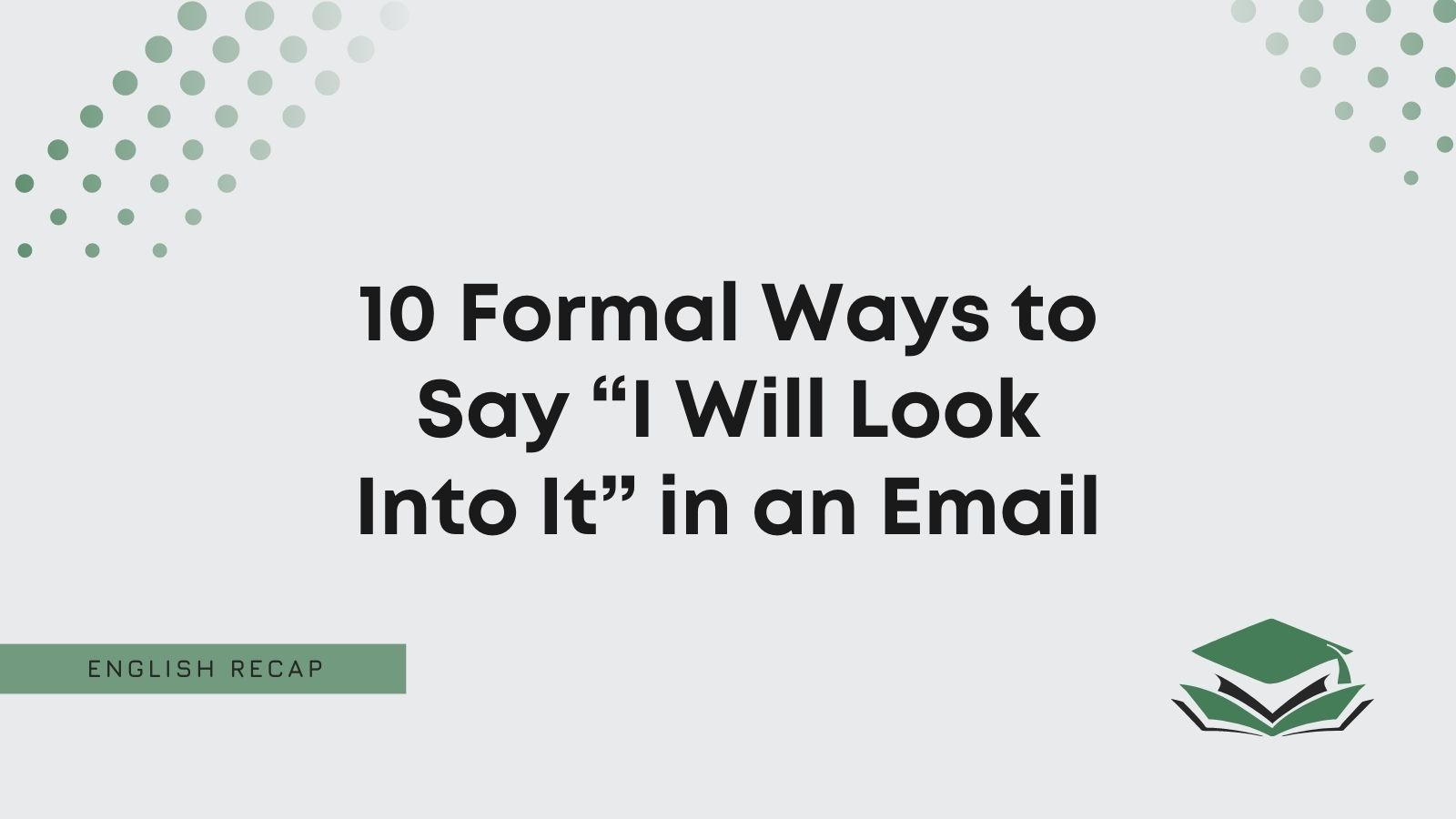Has someone spotted a problem? And now they’ve come to you asking for a fresh set of eyes to look into it, right?
As a reply, you can write “I will look into it.” However, is it the most effective phrase to use in formal emails?
This article has gathered the best synonyms to show you how to say “I will look into it” in an email.
Is It Formal to Say “I Will Look Into It”?
It is formal to say “I will look into it.” It’s very common in business emails when someone asks you to review a problem.
Generally, it means you will find a solution to a problem. It works best if you’re the boss or can understand something better than the person contacting you.
After all, they’ll only reach out and ask for your help if they’re certain you know what you’re doing.
Here’s an example showing you how to use it:
Of course, I will look into it. Leave it with me, and I should have an answer by Friday.
Pros
- It’s a professional way to review something after someone asks for help.
- It’s very polite and formal.
Cons
- It’s quite unspecific.
- Lots of people use it, making it very generic and repetitive.
“I will look into it” is certainly one of the best choices to use in formal emails. However, it’s not the only one. It’s worth having some synonyms ready to go to mix things up.
So, keep reading to learn how to say “I will look into it” professionally. Also, you can review the email examples under each heading to find out more about each phrase.
What to Say Instead of “I Will Look Into It”
- I will see what I can find out
- I’ll take a look
- I will get on top of it
- I’ll see if there’s anything I can do
- Leave it with me
- Let me handle it
- Let me see what I can do
- Let me look into it
- Bear with me while I look into it
- I’ll find a solution
1. I Will See What I Can Find Out
Looking into information when someone has a problem allows you to “find out” solutions. Therefore, you can use “I will see what I can find out” as another way to say “I will look into it.”
It means you’ll do your best to find a solution. Of course, you can’t make any promises when using this phrase.
Still, it’s a great professional alternative that shows you’re willing to try and find a suitable outcome for someone.
Feel free to review this example as well:
Dear Harold,
I will see what I can find out. I’ll let you know when I’ve made some progress regarding this.
All the best,
Charlotte
2. I’ll Take a Look
If you’re trying to sound a bit more friendly, you can use “I’ll take a look.” It’s a good choice in certain emails, but you need to know your audience.
We recommend using it when emailing clients. It shows you’re happy to look into something and find a way to assist them.
Clients will appreciate a slightly more friendly tone if you’ve known them for a while. So, make sure this is the case before using a phrase like “I’ll take a look.”
Here’s a useful email sample to show you how to use it:
Dear Mr. Jenkins,
I’ll take a look to see if there’s anything I can fix. I’m sure I’ll find something that might help us here.
Thank you so much,
Carl Pilkington
3. I Will Get on Top of It
It’s good to show initiative when someone asks you for help. Let’s imagine your boss has come to you with a problem that needs solving.
You can use “I will get on top of it” as a formal way to say “I will look into it.” It’s professional and respectful, showing you’ll do what you can to assist your boss.
If you can follow through and “get on top of it” for your boss, you’ll set yourself up for success. It’ll show your boss that you’re reliable and able to solve problems for them.
You can also review this email example:
Dear Rebecca,
I will get on top of it for you. Thank you so much for coming to me with these issues.
Yours,
Darren Woodman
4. I’ll See if There’s Anything I Can Do
You can’t always be certain that you can help people when they need you. There’s no guarantee you’ll have the right skill set to provide updates and information that people need.
So, you can use “I’ll see if there’s anything I can do” in this case.
It shows you’re willing to try looking into something, but you can’t guarantee success. It’s highly effective in most instances when someone relies on your help.
Try it in an email to a coworker. It shows that you don’t know if you’ll be able to figure out the solution because you both know as much about the situation.
Perhaps this email sample will also help you:
Dear Julio,
I’ll see if there’s anything I can do. You can expect to hear from me again by the end of the week.
Thank you so much,
Dan Kent
5. Leave It With Me
Confidence in your writing allows recipients to believe you know what you’re doing. Try a confident and professional phrase like “leave it with me” when someone needs you.
It shows you’re happy to look into something to get information.
Generally, this works best when you are the boss. You can email employees with “leave it with me” to show that you’ll do everything you can to complete something for them.
We recommend the following example to help you understand it:
Dear Chris,
Thank you for reaching out. Leave it with me, so I can figure out the best course of action.
Best regards,
Dean Whiteman
6. Let Me Handle It
If you’re looking for something slightly more informal, try “let me handle it.” It’s great to use for a more friendly tone in your writing.
Feel free to include it when emailing coworkers. It shows you already have a good idea about how you’re going to solve something.
From there, your coworker can leave it in your hands. It gives them more trust in you and lets them know you have a plan to move forward.
This email example will also explain how to use it:
Dear Mario,
Let me handle it. I already know which clients to contact to get to the bottom of this situation.
Kind regards,
Steven Redgrave
7. Let Me See What I Can Do
It’s worth using “let me see what I can do” instead of “I will look into it.” It shows you’ll do what you can to find answers.
Generally, this is an unconfident phrase. It still works well, but it doesn’t mean you are guaranteed to find anything useful.
We recommend using it when emailing coworkers. That way, you can tell them you’re happy to help but might not find anything useful for them.
Check out this example to see how it works:
Dear Alice,
Let me see what I can do. I can’t make any promises, but I’m sure there are answers out there.
All the best,
Melissa Ellison
8. Let Me Look Into It
When someone comes to you for help, it’s important to try your best to do what you can for them. After all, they’re relying on you to look into something on their behalf.
Try “let me look into it” as a polite and professional way to help someone. It gives them faith in you and suggests that you might be able to find a suitable solution.
If you’re still stuck, review this example:
Dear Ginny,
Thank you for mentioning this. Let me look into it, and I’ll see what I can find. Until then, have a good week.
Yours,
Bear Magner
9. Bear With Me While I Look Into It
You can also use “bear with me while I look into it.” It’s quite a polite way to ask for time to find a solution.
“Bear with me” is the key here. It shows you’re willing to help someone, but you’ll need to take some time to ask around and find out the answers.
We recommend using it when emailing customers. It suggests you’re happy to help them, but you don’t know when you’ll reply again.
Here’s a great email sample to show you how it works:
Dear Joe,
Bear with me while I look into it. You’ll be the first person I contact when I have more information to share.
Kind regards,
Tom Woodley
10. I’ll Find a Solution
For a more direct and clear alternative, try “I’ll find a solution.” It’s a very confident replacement for “I will look into it,” showing you’re certain you’ll find the best way to handle a situation.
We recommend using it when you’re sure you can fix a problem. It’s very formal and shows you’re not going to stop until you find the most suitable way to correct something.
Generally, you would use this when emailing employees. After all, you’ll want to be in a position of authority to get away with a phrase like this.
This sample email will also help you with it:
Dear Steven,
Thank you so much for reaching out to me. I’ll find a solution immediately and get back to you when I know more.
Yours,
Patrick Lowe

